第11章 领导(1)
管理学杨文士第三版第11章领导职能概述
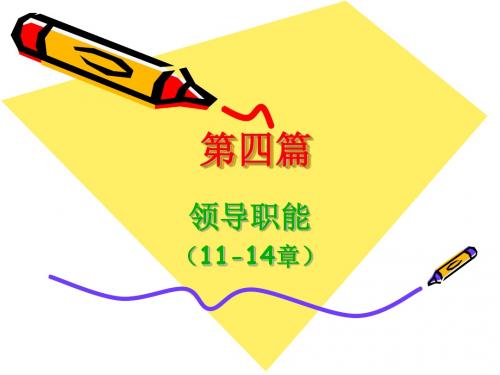
(五)沟通联络原理
(六)激励原理
二、做好领导工作的要求
(一)不断鼓舞人们的士气
——怎么做
(二)把握人们的工作目的,了解人们变化着的期望 (三)注意社会环境对人的影响 (四)进行合理安排 综上所述,对于执行领导工作职能的要求,可以 概括为一句话,即“通过三个方面,达到一个目的”。
有效沟通
通过“三个方面”
从工作主体看: 领导者是管理者的一部分。
从工作客体看: 管理的对象是人财物,领导的对象是人。
从工作手段看: 管理包括计划、组织、领导、控制,领导 主要是用权力影响人。
四、领导的作用:指挥、协调、激励
组织
个人
个人目标与组织目标相结合 积极性
第2节 领导的原理和要求
一、领导的基本原理
(一)指明目标原理 (二)协调目标原理 (三)命令一致性原理 (四)直接管理原理
•
第11章结束
第1节 领导职能的含义和作用
一、领导的含义
领导就是对组织内每个成员(个体)和全体成 员(群体)的行为进行引导和施加影响的活动过 程,其目的在于使个体和群体能够自觉自愿并有 信心地为实现组织的既定目标而努力。
即:领导是指挥或带领,引导和鼓励部下为实现目标
而努力的过程。
领导者:在组织中发挥领导作用的人。
适宜的激励措施与方法
不断改善和完善领导作风和方法
达到“一个目的” :创造一个有利于实现组织目标的氛围。
本章总结:
• 本章主要介绍了 领导的含义与实质、领
导和管理的异同,并使我们了解领导工 作的原理与要求,对做好领导工作奠定 了理论基础。
本章练习题:
• 1、领导工作的含义与实质是什么? • 2、领导与管理有什么区别? • 3、简述领导工作的原理和要求。
管理心理学课件第十一章 领导
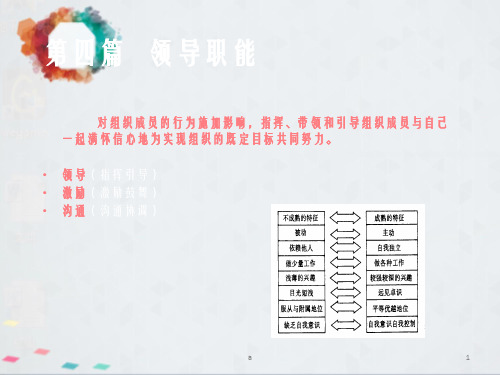
• 不存在一种“普遍适用”的领导方式
领导方式的有效性 S=f(L,B,E) * 领导者 * 被领导者 * 领导环境
• 领导连续统一体理论 • 菲德勒模型 • 路径—目标理论
• 不成熟—成熟理论
• 情景领导理论
a
38
1. 领导连续统一体理论
• 坦南鲍姆(Robert Tannenbaum)和施米特(Warren H.Schmidt)提出 • 领导风格的多样性 * • 领导方式随机制宜 *
a
34
领导方格图 *
a
35
老杜的一上午
• 早晨8点30分,公司常务副总、董事老杜接到市政府电话,通知企业开展 冬季消防检查;10 分钟后老杜打电话给保卫部门,通知他们去处理这项 要求; 9点15分老杜接到库房电话,被告知房屋后墙再次被人敲了个洞, 又有几十箱产品被盗; 8分钟后,老杜打电话给市公安局请他们改善本 地治安状况…。整个上午老杜接电话、打电话,倒也挺忙。
a
39
领导连续统一体模型 *
a
40
2. 菲德勒模型
a
41
• 两种领导方式: 任务导向型、关系导向型
• 三种领导环境因素: 上下级关系、任务结构、职位权力
• 八种(三类)领导环境类型: 有利、一般、不利
• 有效的领导方式: 有利与不利——任务导向型 一般——关系导向型
a
42
你怎样看?
• 某位领导者说:“我上班的第一件事,就是首先过问今天哪些员工过生日, 并及时派秘书送去生日蛋糕和贺卡。”对于这种做法,各方面反应不一。根 据菲德勒模型,你认为这种领导方式更适合于怎样的领导情景?
• 预算拨款
a
8
(二)领导艺术
• 领导过程的艺术性在于将组织成员个人愿望和需要的满足与组织目标的实现 结合起来。
第11章 领导

三、吉赛利的研究
• 美国管理心理学家吉赛利(Echiselli)对 来自美国90个企业的306名被试者进行了研 究,通过研究将领导者的特质分为3大类, 包括13项特质 • 吉赛利也发现,对于成功而言,13项特质 的重要性不是等价的,有些特质起着非常 重要的作用,有些起着中等重要的作用, 有些作用则很微弱,吉赛利按照重要程度 给每个特质进行了赋值
• 从20世纪初到20世纪80年代左右,领导理 论的发展大概经历了三个阶段:注重领导 者性格、素质等方面研究的领导特性理论 阶段;注重领导行为方式研究的领导行为 理论阶段;注重结合领导领导情景研究的 领导权变理论阶段。
第二节 领导特性理论
• • • • 一、斯托格蒂尔的研究 二、鲍莫尔的研究 三、吉赛利的研究 四、波特的研究
第十一章 领导
本章要点
• • • • • 领导的相关概念; 领导特性理论; 领导行为理论; 领导权变理论; 领导理论的新观点。
第一节 领导过程 第二节 领导特性理论 第三节 领导行为理论 第四节 领导权变理论 第五节 领导理论的新观点
第一节领导过程
• • • • 一、领导的含义以及过程 二、领导者的作用以及权力 三、领导者与管理者 四、领导理论基础
一、斯托格蒂尔的研究
• 美国心理学家斯托格蒂尔(Stogdill)于19 48年归纳了领导者的六类品质特性:
1.身体特性 2.社会背景 4.性格特征 5.工作作风 3.智力才能 6.社交技能
二、鲍莫尔的研究
• 美国普林斯顿大学鲍莫尔(Baumol)教 授提出了企业家应该具备的十个条件:
1、合作精神 2、决策能力 3、组织能力 4、精于授权 5、善于应变 6、敢于求新 7、勇于负责 8、敢担风险 9、尊重他人 10、品德高尚
第十一章 领导与权力

• 有效领导方式的选择方法 • 当下属成熟程度为(M1)时,选择命令型领 导方式。 • 当下属成熟程度为(M2)时,选择说服型领 导方式。 • 当下属成熟程度为(M3)时,选择参与型领 导方式。 • 当下属成熟程度为(M4)时,选择授权型领 导方式。
24
领导关系和员工的行为关系通过成熟 度联系起来,当下属的成熟度水平不断 提高,领导者不但可以减少对活动的控 制,而且还可以不断减少关系行为,形 成一种周期性的领导方式。
6
2.非职权影响力
非职权影响力不是外界附加的,它产生于 个人的自身因素,与职位没有关系。 ①专长权性权力:是知识的权力,指的是因 为人在某一领域所特有的专长而影响他人。
②感召权性权力:是由于领导者拥有吸引别 人的个性、品德、作风而引起人们的认同、赞 赏、钦佩、羡慕而自愿地追随和服从他。
7
(二)权力的基础
2
•
领导与管理有着本质的区别。领导是管理的 一个方面,属于管理活动的范畴;管理的权力是 建立于合法的、强制性权力基础上的,而领导的 权力既可建立于合法的、强制性权力基础上,也 可以建立在个人的影响力和专家权力的基础上。 • 因此领导者不一定是管理者,管理者也并不 一定是领导者。两者既可以合二为一,也可以相 互分离。 • 领导的作用:指挥作用,协调作用和激励作 用。
4
二、领导权力的构成
(一)权力的来源
领导影响力
职权影响力 非职权影响力
法 定 权
强 制 权
奖 赏 权
专 长 权
感 召 权
5
1.职权影响力 职权影响力实质是指社会或一个组织赋予某些 人一定的职务、地位、权力等,使之具有支配下属 的影响力。这种影响力与特定的个人无关,只与职 务发生联系。 ①法定权性权力:组织授予领导者一定的职位,使其 占据权势地位或支配地位,可以对下属发号施令。 ②奖赏权性权力:用激励手段鼓励下属努力完成组织 目标。 ③惩罚权性权力:指通过强制性的处罚或剥夺而影响 他人的能力。
第十一章 领导

一、特质理论
3.不足之处: (1)忽视了下属的需要; (2)没有指明各种特质之间的相对重 要性; (3)没有对因与果进行区分; (4)忽视了情境因素。
二、行为理论
(一)行为理论 (二)五种行为理论 1.勒温三分法理论 2.利克特四种管理方式 3.领导行为四分图理论 4.管理方格论 5.领导行为连续统一体理论
(二)五种行为理论
1.勒温三分法理论 2.利克特四种管理方式 3.领导行为四分图理论 4.管理方格论 5.领导行为连续统一体理论
4.管理方格论
(1)美国管理学者布莱克和莫顿在俄亥 俄州立大学领导行为四分图基础上, 进一步研究后提出的。他们把领导行 为四分图的纵、横坐标都分为九等分, 纵横交错便形成有81种领导风格。
【走进管理】
视市场相结合,从而使超级电视台获得 了极大的成功。而勇敢者棒球队也于 1992年挤身于世界强手之列。 1981年,特纳认定24小时新闻直播 必有市场,尽管当时没有一个人赞同此 看法,他还是倾其全部财力创立有线电 视新闻网(CNN),获得了令人难以置 信的效益,并且,由于对1991年海湾战 争的报道而赢得了无数赞誉。1986年, 泰德·特纳又一次投赌,买下了联合艺 术家电影图书馆。与以往一样,批评家
案例思考11-1 来自下属的威胁
得十分出色。 赵斌工作独立性很强,他的到来使朱杰的工作轻 松了很多。只是在涉及本部门外要求的决策时,他才 会来询问赵斌。在某种意义上说,朱杰很为这里情况 的变化感到欣慰。但有两件事使他担忧:一是部门内 有些人员甚至开始同赵斌谈个人的事情。朱杰比赵斌 大20岁,他觉得在这些方面自己更有经验。二是赵斌 在本部门以外也交不少朋友,尤其是同公司的两位资 深经理有很好的关系。对此,朱杰感到很不安。他想 赵斌在职务上超过他只是早晚的事。 朱杰决定采取行动。他开始寻找机会在同事面前
组织行为学——领导力

领导者会区别看待下属群内组员 与领导者旳态度或性格相近让领导者感到能力更强态度更主动,能够取得领导者旳关注取得某些特权取得较高旳绩效评分流失率较低更高旳工作满意度
2.4 领导-组员互换模型
虽然是领导者做出选择,但真正对决策起作用旳是下属旳特征
3.2 全距式领导模型
3.2 变革型领导怎样发挥作用?
发明力 鼓励下属更具创新能力目旳 下属追求更远大旳目旳,并有更多旳个人承诺愿景 激发下属旳责任感和更大旳信任
3.2 变革型领导评价
有效地应用于多种层次旳工作和职位在小规模旳企业中更有效某些管理者与下属关系越亲密,发挥旳作用越大在高权力距离和集体主义文化背景旳群体中效能更高变革型领导能够产生主动旳成果,例如较低旳人员流失率和更低旳缺勤率
11-8
2.2 行为理论:密歇根大学旳研究
强调工作中旳技术元素人员是实现目旳旳手段
关注人际关系接受个体旳差别性
11-9
特质理论与行为理论旳总结
特质理论与行为理论是否有联络诸多优异领导者离开后,组织依然成功拥有某些特质,或做出恰当行为旳领导者,依然有可能失败
2.3 权变理论
因为某一领导风格不可能在任何情境下都合用,所以需要将领导风格与其工作环境相结合。费德勒模型 领导-组员互换理论
变革型领导与魅力型领导
两者对鼓励、工作满意度、绩效、效能和盈利能力等都具有正向旳影响变革型领导是比魅力型领导更宽泛旳一种概念变革型领导更鼓励下属质疑领导者本人旳世界观,魅力型领导则不会
4 真诚领导:道德与信任是领导力旳基础
真诚领导了解自己旳角色是什么,清楚地懂得自己旳信仰和价值观,而且会坦率地根据自己旳信仰和价值观采用行动发明信任鼓励开放旳沟通
管理学第11章 领导概论

区别:
领导是管理的一个方面,属于管理活动的范畴,但除 了领导,管理还包括其他内容。
管理的权力是建立在合法的、强制性权力基础上的; 而领导的权力既可以建立在合法的、强制性权力基础 上,也可以建立于个人的感召力和专长权力等基础上 。
领导活动侧重于对人的指挥和激励,更强调领导 者的影响力、艺术性和非程序化管理;而管理活 动更强调管理者的职责以及管理工作的科学性和 规范性。
非职位权力不是外界附加的,它产生于个人的自 身因素,与职位没有关系。
a.非职位权力构成
①感召权:由于领导者拥有吸引别人的个性、品德 、作风而引起人们的认同、赞赏、钦佩、羡慕而自 愿地追随和服从他。
②专长权:知识的权力,因为某一领域所特有的专 长而影响他人的能力。
b.制约非职位权力的因素
①品格;②才干;③知识;④情感。
领导者既存在于正式组织中,也存在于非正式组织中 ;管理者只存在于正式组织中。
管理与领导的区别
项目
管理
领导
对 象 人、财、物、信息、 人
变 动 小(规范化)
大(因人而导)
管制方法 规章制度、流程 愿景、文化、理念
进行方式 指示、督促、考核 期望、鼓励、承诺
经常用语 效率、标准、系统 荣誉、自觉、激励
▪ “从来没有无能的士兵,只有无能的 军官。”——拿破仑
▪ 领导是实现组织目标的关键。
学习目标
知识点:
1、掌握领导的概念,领导者与管理者 的区别,及领导者的权力来源;
2、领导者风格类型 3、几种有代表性的领导理论
技能点:
培养有效运用权力的能力
第一节 第二节 第三节
领导的内涵 领导风格类型
领导理论
一
按权力运用方式划分
参考试题 第十一章 领导
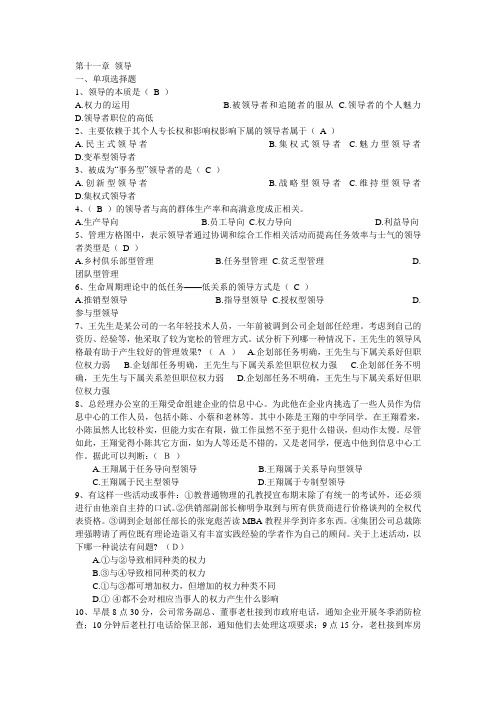
第十一章领导一、单项选择题1、领导的本质是(B )A.权力的运用B.被领导者和追随者的服从C.领导者的个人魅力D.领导者职位的高低2、主要依赖于其个人专长权和影响权影响下属的领导者属于(A )A.民主式领导者B.集权式领导者C.魅力型领导者D.变革型领导者3、被成为“事务型”领导者的是(C )A.创新型领导者B.战略型领导者C.维持型领导者D.集权式领导者4、(B )的领导者与高的群体生产率和高满意度成正相关。
A.生产导向B.员工导向C.权力导向D.利益导向5、管理方格图中,表示领导者通过协调和综合工作相关活动而提高任务效率与士气的领导者类型是(D )A.乡村俱乐部型管理B.任务型管理C.贫乏型管理D.团队型管理6、生命周期理论中的低任务——低关系的领导方式是(C )A.推销型领导B.指导型领导C.授权型领导D.参与型领导7、王先生是某公司的一名年轻技术人员,一年前被调到公司企划部任经理。
考虑到自己的资历、经验等,他采取了较为宽松的管理方式。
试分析下列哪一种情况下,王先生的领导风格最有助于产生较好的管理效果? (A) A.企划部任务明确,王先生与下属关系好但职位权力弱 B.企划部任务明确,王先生与下属关系差但职位权力强 C.企划部任务不明确,王先生与下属关系差但职位权力弱 D.企划部任务不明确,王先生与下属关系好但职位权力强8、总经理办公室的王翔受命组建企业的信息中心。
为此他在企业内挑选了一些人员作为信息中心的工作人员,包括小陈、小蔡和老林等。
其中小陈是王翔的中学同学。
在王翔看来,小陈虽然人比较朴实,但能力实在有限,做工作虽然不至于犯什么错误,但动作太慢。
尽管如此,王翔觉得小陈其它方面,如为人等还是不错的,又是老同学,便选中他到信息中心工作。
据此可以判断:(B)A.王翔属于任务导向型领导B.王翔属于关系导向型领导C.王翔属于民主型领导D.王翔属于专制型领导9、有这样一些活动或事件:①教普通物理的孔教授宣布期末除了有统一的考试外,还必须进行由他亲自主持的口试。
第十一章 领导概论

第二节 理想的领导者与领导集体
一、领导者素质及条件
传统的特性理论(伟人说)
• 认为领导者的品质是天生的,与后天的培养、训练和实践无关。 现代特性理论 • 认为领导者的品质和特征是在后天的实践环境中逐步培养、锻炼 出来的。
• 杨澜访谈录--对话李东生
12
13
好的领导者应具备哪些品质(领导特质理论)
知识结构
• 知识结构是指领导班子中不同成员的知识水平构成。 领导班子成员都应具有较高的知识水平。没有较高的 文化知识素养,就胜任不了管理现代化企业的要求。 随着我过社会经济的发展,职工的文化水准在不断提 高,各类组织的各级领导都在向知识型转变。
20
能力结构 • 能力是一个内容十分广泛的概念,它包括决策能力、判 断能力、分析能力、指挥能力、组织能力、协调能力, 等等。每个人的能力是不相同的。因此,企业领导班子 中应包括不同能力类型的人物,只有这样,才能形成最 优的能力结构,在企业管理中充分发挥作用。 专业结构 • 专业结构是指在领导班子中各位成员的配备应由各种专 门的人才组成,形成一个合理的专业结构,从总体上强 化这个班子的专业力量,在现代化企业里,科学技术渗 透一切领域,科学技术是提高生产经营成果的主要手段。 因此,领导干部的专业化,是搞好现代企业生产经营的 客观要求。
16
• 业务技能
• 1、较强的分析、判断和概括能力。 2、决策能力。 3、组织、指挥和控制的能力。 4、沟通、协调企业内外各种关系的能力。 5、不断探索和创新的能力。 6、知人善任的能力。
• 身体素质
• 领导者负责指挥、协调组织活动的进行,是一项不仅需要 足够心智、而且消耗大量体力的工作,因此,必须有强健 的身体,充沛的精力。
6
第十一章 领导与权力
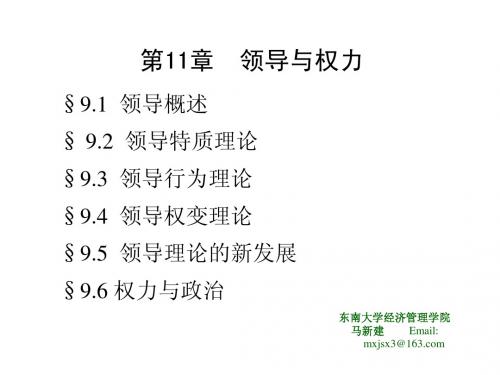
□ 连续带模式的价值 □ 连续带模式理论的改进
图9-10 经理非经理人员 行为模式连 续分布场
三、领导生命周期理论(赫塞—布兰查德情境理论) □ 主要观点:下属的成熟度水平是一权变变量,领
导风格应与被领导者的成熟程度相适应,方能达成有效 领导。
• 成熟度:个体完成某一具体任务的能力和意愿程度。 □ 情境理论的四种具体的领导风格 • 指示(高任务—低关系):领导者定义角色,告诉下属干什 么、怎么干、何时何地去干,其强调指导性行为。 • 推销(高任务—高关系):领导者同时提供指导性行为与支
① 指导职责。
② 服务职责。 ③ 协调职责。 ④ 激励职责。 2. 领导绩效 由被领导者群体活动的 绩效来表现和衡量。
(四)领导与管理的联系与区别 1. 联系:① 领导是从管理中分化来的; ② 都有较强的复合性和相容性; ③ 从事管理工作同时也在担负着领导工作。 2. 区别: 领导主要处理变化的问题; 领导具有全局性; ① ④ 管理主要处理复杂的问题; 管理具有局部性;
第11章 领导与权力
§9.1 领导概述 § 9.2 领导特质理论 §9.3 领导行为理论 §9.4 领导权变理论 §9.5 领导理论的新发展 §9.6 权力与政治
东南大学经济管理学院 Email: 马新建 mxjsx3@
§9.1 领导概述
一、有关领导的基本概念 (一)领导的含义与本质
的许多品质靠后天培养和训练形成。 □ “才能本身并不就是成就”。
二、现代特性理论
□领导者的素质不是生而具有,而是在实践中逐步 形成和积累起来的,可以通过教育加以培养。研究领 导特质可以为选择、使用和培养领导者提供明确的标 准、方向和内容。 □美国企业界:合格领导者应具有的10种品质:
(1)合作精神(2)决策才能(3)组织能力 (4)精于授权(5)善于应变。(6)勇于负责(7)敢于求新 (8)敢担风险。(9)尊重他人。(10)品德超人。
第11章领导

案例 三种不同的领导方式
• 案例A:任厂长 某汽车公司装配厂的任厂长,从一上任开始,就不同意公司裁员
的做法,他给厂里每个人机会以充分证明自己的价值。在他任期内,全 厂5000名职工中只有极少数人被解雇。他首先为职工们建造了供职工们 使用的餐厅和卫生间。午餐时,他还亲自上餐厅,跟职工们打成一片。 他倾听他们的抱怨,征求他们的意见和合理化建议,鼓励班组定期开会 来解决共同的问题。通过“一日厂长制”等活动,创造一切可能的机会 让职工们参与全厂的长远规划。任厂长不仅坚持每日2小时在现场走动 办公,而且还为管理人员和一线工人安排了不断解决问题的对话,通过 对话,他希望管理人员知道他们为一线工人提供的服务是怎样的“不到 位”,从而激发职工对企业的忠诚。
他对下属关怀备至,下属人员遇到什么难处都愿意和他说,只要厂 里该办的,他总是很痛快地给予解决。职工私下说他特别会笼络人。
当然,任厂长也承认装配厂生产率暂时不如其他同类企业,但他坚 信只要他的职工们有高昂的士气,定会取得高的绩效。
• 案例B:严厂长
某钢厂严厂长认为对下属人员采取敬而远之的态度对一个厂长 来说是最好的领导方式,所谓的“亲密无间”只会松懈纪律。他一天 到晚绷着脸,下属人员从未见他和他们谈过任何工作以外的事情,更 不用说和下属人员开玩笑了。他到哪个部门谈工作,一进门大家的神 情都变得严肃起来,犹如“一鸟入林,百鸟压音”,大家都不愿和他 接近。严厂长把全厂的工作任务始终放在首位,在他看来,作为一个 好的领导者,无暇去握紧每一个职工的手,告诉他们正在从事一项伟 大的工作。所以他总是强调对生产过程、产量控制的重要性,坚持下 级必须很好地理解生产任务目标,并且保质保量地完成。他经常直接 找下属布置工作,中层管理人员常常抱怨其越级指挥,使他们无所适 从。严厂长手下的几员“大将”被“架空”已成家常便饭。职工们有 困难想找厂里帮助时,严厂长一般不予过问,职工们说他“缺少人情 味。”久而久之,严厂长感到在管理中最大的问题就是下级不愿意承 担责任,他们对工作并非很努力地去做,全厂的工作也只是推推动动 ,维持现有局面而已。
领导学概要第十一章 领导绩效与考评

第二节 领导绩效考评的原则与方法
二、领导绩效考评的原则
(三)民主公开原则 第一,领导绩效评估要在追随者和组织成员参与的基础上进行。 第二,领导绩效评估工作要接受组织成员的监督。 第三,领导绩效评估结果要公开。
第二节 领导绩效考评的原则与方法
二、领导绩效考评的原则
(四)全面系统原则 第一,显绩考评与潜绩考评相结合。 第二,政治和业务相结合。 第三,眼前和长远相结合。 第四,局部和全局相结合。 第五,主观和客观相结合。 第六,目的和手段相结合。 第七,领导者个体考评与领导集体考评相结合。
第二节 领导绩效考评的原则与方法
一、领导绩效考评的目的
(一)正确评价领导者 (二)发现与选拔领导者 (三)合理使用领导者 (四)公正奖惩领导者 (五)激励约束领导者
第二节 领导绩效考评的原则与方法
二、领导绩效考评的原则
(一)统一规范原则
第一,要制定统一规范的考评指标和考评体系。 第二,要形成制度,严格执行。
领导绩效如何,取决于领导者如何履行自己的职责—决策和发动,其中主要包含三个要素:第一, 领导能力。第二,领导效率。第三,领导效益。
第一节 领导绩效的内涵与特征
一、领导绩效的内涵
(二)领导绩效的具体内容 1.用人绩效
2.决策办事绩效 3.时间绩效
4.整体贡献绩效
第一节 领导绩效的内涵与特征
二、领导绩效的特征
第二节 领导绩效考评的原则与方法
二、领导绩效考评的原则
(六)贡献为主原则 领导绩效评估尽管包括领导能力、工作态度、领导环境和工作实绩等多个方面,但必须坚持贡献 为主原则,即要以实际贡献和工作成绩作为重要标准来评估领导者履行职责的状况。 第一,坚持贡献为主的原则可以使评估具有客观性。 第二,坚持以贡献大小来评估领导活动的优劣,可以把各级领导机关和领导者的注意力引导到正 确的组织发展目标上来,从而使领导者可以脚踏实地地去从事各种领导活动,有助于增强领导者的责 任感,促使领导者把效益作为衡量自己领导工作绩效的重要标准。 第三,坚持以贡献为主的原则,能使领导者充分发挥自己的潜力和特长,组织就能够根据被评估 者的贡献及时发现人才,提拔人才。
管理学第11章 领导概论
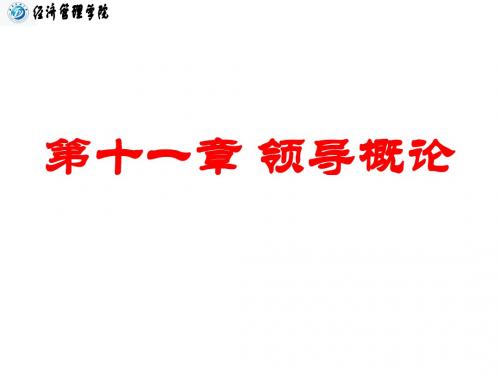
成熟度是个体对自己的直接行为负责任的能
力和意愿。包括工作成熟度(Job Maturity)
和心理成熟度(Psychological Maturity)。 工作成熟度是下属完成任务时具有的相关技 能和技术知识水平。
心理成熟度是下属的自信心和自尊心。
高
低任务 高关系
参与S3
推销S2
高任务 高关系
关 系 行 为
领导者行为
情景变量 取决于 下属的特点 环境因素 导致
最终目标
指 导
支 持 参 与
型
型 型 工作绩效 工作满足度
成就导向型
四种领导者行为-- ①指导型领导方式:明确任务并给予具体指导, 类同于定规维度; ②支持型领导方式:更多地表现出对下属的关 怀,类同于关怀维度; ③参与型领导方式:在决策时询问并评价下属 的意见和建议,允许其参 与决策; ④成就导向型领导方式:设定有挑战性的目标, 并期望下属发挥最佳水平。 豪斯认为同一领导者可以根据情景不同表 现出任一种领导方式。
第十一章 领导概论
引 组织职能如何运作?
学习目的
第一节 领导的内涵:领导职能概述,领导内涵, 领导职责与作用,领导者的素质、 条件与创新精神; 第二节 领导者的类型:领导班子,领导者的选 择、考核和培训,企业家; 第三节 领导方式及其理论:领导方式行为论, 领导方式情景论,领导的有效性。 重点:领导的职责和素质,领导类型,领导理论 难点:领导的职责和素质,领导类型,领导理论
(2)菲德勒模型
菲德勒的领导权变理论认为任何领导方式都可能在一定 的环境内有效,其有效性完全取决于是否与所处的环境相适应。
a.三种权变因素:①职位权力的大小;②任务结构是否明确; ③上下级关系(下属乐于追随的程度)。
管理组织学高教出版周三多主编第二版第11章知识题

第十一章领导一、填充题1.领导的作用包括、和。
2.领导是指、、和部下为实现目标而努力的过程。
3.领导的核心在。
4.领导者权力运用方式,可以将领导风格分为两类:和。
5.按领导者在领导过程中进行制度创新的方式,可以把领导风格分为和。
6. 按领导者在领导过程中的思维方式,可以把领导者分为两类:和。
7.战略的基本特征是行动的、和。
8.战略性领导行为系之拥有、、并,以创造所必需的战略变革能力。
9.布莱克和穆顿在提出管理方格式,列举了五种典型的领导方式:、、、和。
10.按照权变理论,领导方式是领导者的、、的函数。
11.权变理论中的领导者特征主要指的是领导者的、和。
12.费德勒模型认为在环境较好和较差的情况下,采用LPC领导方式比较有效,在环境中等的环境下,采用LPC领导方式比较有效。
13.在权变理论中,低LPC型领导比较重视的完成,高LPC型领导比较重视。
14.李克特及其同事(1974)的研究结果发现了两种不同的领导方式:和。
15.密执安大学领导行为方式研究的结论是,与高的群体生产率和高满意率相关,而则与低的群体生产率和低满意度相关。
16.美国俄亥俄州立大学的研究人员弗莱西(E.A.Fleishman)和他的同事们的研究则把发现的十种类型的领导方式分为两个维度,即和。
17.布莱克和穆顿提出的管理方格论时,把管理人员按他们的和进行评估。
18.菲德勒将权变理论具体化为三个方面,即、和。
19.路径—目标理论提出了两类情景变量作为领导行为—结果关系的中间变量,即和。
20.根据赫塞和布兰查德对成熟度的定义,可以把成熟度分为和。
21.领导的权力通常就是指,在组织中就是指。
22.领导权力的五种来源有、、、、。
23.管理方格论中,领导者只重视任务效果而不重视下属的发展和士气的类型是。
24.LPC评价是询问领导者对的评价。
25.在领导生命周期理论中,保罗·赫塞补充了一个因素,表示领导行为在确定是任务绩效还是维持行为更重要之前应当考虑的因素,即。
管理学(第11章)
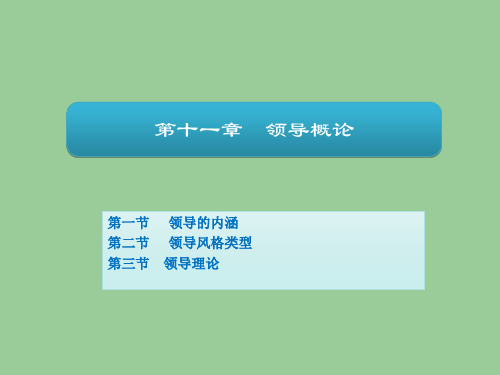
下页
走进管理 看球赛引起的风波
分析与思考: 1.车间主任会采取什么举动? 2.你认为年轻人的作法合理吗? 3.在一个组织中如何采取有效措施解决群体需要与组织目标 的冲突? 4.如果你是这位车间主任,应如何处理这件事?
返回
企业的领导者,特别是一把手,一言一行、一举 一动都关系到企业的兴衰成败。有好的领导才有 成功的企业,一个企业的衰落,大部分是由领导 造成的。
22
(二)与个人特性相关的权力:
1、感召性权力:由于领导者拥有吸引别人的个性、品德、作风而引
起人们的认同、赞赏、钦佩、羡慕而自愿追随和服从他。如:无私工 作、刚正不阿、主持正义、清正廉洁等。
如果你敬重某个人,以至于你的行为以他为榜样,你的态度追随着他 的态度,那么这个人对你就有感召权利。
2、专长性权力:因在某一领域所特有的专长而影响他人的权力。
强制权
领导者方面
下属方面
奖赏权
法定权
感召权
个人魅力
专长权
个人专长
职位 恐惧
职位 欲望
职位
习惯观念
信任
尊敬
于先生受命前往一家多年亏损的企业担任厂 长。到任之后,他待人热情,早上早早地站 在工厂的门口迎候大家,如果有的员工迟到, 他并不是批评和指责,而是询问原因,主动 帮助员工解决实际困难。一周下来,大家看 到厂长每天都提前到厂,而且又待人热情, 原来习惯于迟到的员工也不迟到了。从这件 事情来看,是什么权力使于厂长产生了如此 大的影响力? A.个人影响权 B.专长权 C.法定权 D.A和C
9
11.1领导的内涵
领导是指挥、带领、引导和鼓励部下为实现目标
而努力的过程。
第十一章 领导概论

项 目 来 源 范 围 大 小 方 式
职位权力 法定职位,由组织 带来规定 受时空限 制,受权 限限制 不因人而异
影响力 完全依靠由个人素质、品质、 业绩和魅力而来 不受时空限制,可以超越权限, 甚至超越组织的局限 因人而异,同一职位的经理, 有的有影响力,有的没有
以行政命令的方式实现, 自觉接受,是一种内在的影响 是一种外在的作用 服从、敬畏,也可以调 职、离职的方式逃避
2012-10-4
管理学院
朱玉清
20
§3 领导理论
领导方式的基本类型 (1)专制式。权力集中在领导层一个,又 称为“专权式”、“独裁式”。 (2)民主式。权力是共同协商使用。 (3)放任式。极少用权,几乎全部下放。
2012-10-4
管理学院
朱玉清
21
放任式
专制式
民主式
工作效率
最低
高
最高
任务目标
完不成
9, 1
1
2
4 5 6 关 心 生 产 图: 管理者方格
管理学院 朱玉清
3
7
8
9
2012-10-4
25
三、领导情景论
1、菲德勒权变理论: 目前国外权变理论有两大流派: 一派认为领导者的个性特征是稳定的,要 提高效率,必须探索领导者个性特征与情景特 征之间的关系,安排领导者到适合他个性的环 境中。 另一派认为领导者的领导作风和领导行为 可以改变,优秀的领导者应善于分析下级个性 特点和环境因素,并据具体条件选择运用恰当 的领导方式。
2012-10-4
管理学院
朱玉清
15
问后来问及此事时,他为此非常抱歉,并承认如 果能见面确实会对他非常有益。这位顾问回答他 的是:“我倒不担心你会错过什么,只是公司需 要你去认识这个人。” 第四,领导者不应勉强要求那些不切实际的个 人效忠,要知道创造性的人物常常只忠实于某种 理念,因而也常常显得不怎么合群。创新者真正 需要的是更多的机会和公正的对待,而不是森严 的等级和集权的控制。他们的成果得益于他们的 善于发现和普遍联系。人们都知道阿基米德在洗 澡时发现浮力原理的故事,创新者对各种各样的 事物都有独到的洞察力。惠普公司则是从车库里 起的家。领导者应了解此种关联的潜力,并要让 创新者们能够去发现它们。 最后,领导者应小心衡量创新者所作出的贡献。 不要把所有的事物都拿来量化。财务数据和法令 条文固然重要,但那并不是将来的一切。
领导学 第十一章 领导与执行1
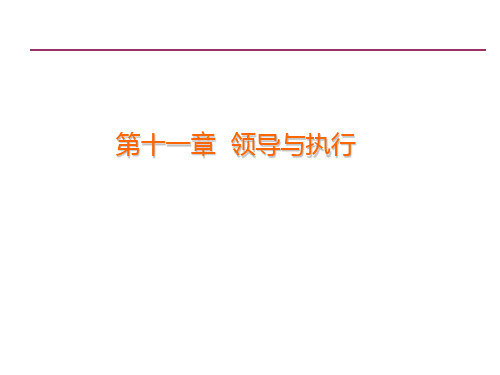
以制度为行动指南的管理方针,永不草率行事, 并且不轻视任何小事。
© 2005
13
中国企业执行力低下表现症状
根据调查分析结果对企业现状分类进行量化分析
5%的人看不出来是在工作,而是在制造矛盾,无事必生非=破坏性的做; 10%的人正在等待着什么=不想做; 20%的人正在为增加库存而工作=“蛮做”、“盲做”、“糊做”; 10%的人由于没有对公司做出贡献=在做,而是负效劳动; 40%的人正在按照低效的标准或方法工作=想做,而不会正确有效地做;
组织流程臃肿会导致执行力低下!
© 2005
11
执行力低下——执行不力
联想在1999年进行ERP改造时,业务部门不积极执行,使流程 设计的优化根本无法深入,长此下去,联想必将瘫痪; 最后柳传志不得不施以铁腕手段,才杀灭企业内部试图拖垮 ERP以保全既得利益的阴暗心态;
,
22
责任机制:凝聚组织的执行力
责任病毒从一方传到另一方,让人无从察觉, 就像是看不见的微生物一样。
感到权力被剥 夺 承担起争取成 功的全部责任
专注于他人而 不是自己的责 任
逃避责任
承担过多的责任
即使明知无望 也要努力抗争 忽视警告信号
尽量少承担争 取成功的责任
陷入麻烦 无法摆脱
© 2005
23
责任阶梯:识别执行者的责任大小
1.考虑各个选项并做出决定,然后通知对方
20
建立执行文化:上行下效
怎样才能建立起执行文化?答案只有一个:各级领导必须参与到自己职能部 门的具体工作之中,亲力亲为,成为带动全局的发动机!尤其是最高领导者。 我们认为,领导者需要有一种执行的本能,他必须相信,“除非我使这个计 划真正转变成现实,否则我现在做的一切根本没有意义”,因此他必须参与到具 体的运营过程中,参与到员工中去。 只有这样,他才能对企业现状、项目执行、员工状态和生存环境进行全面综 合的了解,才能找到执行各阶段的具体情况与预期之间的差距,并进一步对各个 方面进行正确而深入的引导。这才是企业领导者最最重要的工作。而且不论组织 大小,这些关键工作都不能交付给其他任何人。 每一级组织的“上行下效”行为,事实上就是一种观念和思想的表达,即领导 者承担企业全局责任,中层担负部门的全局责任,员工担负其任务应有的责任。 制度层层分解,每一层对下一层负责,每一层都努力完成自己分内的工作。这 种思想像空气一样弥漫在企业的每一个角落,它将形成一种最适合企业运营的文 化。 只有当适当的人在适当的时间开始关注适当的细节的时候,一个组织才能真正 落实一项计划。将领导者心中的理念转变为整个组织的实际行动,是一个相当漫 长而又曲折的过程,这里面有预期的回报,更有突如其来的风险。
- 1、下载文档前请自行甄别文档内容的完整性,平台不提供额外的编辑、内容补充、找答案等附加服务。
- 2、"仅部分预览"的文档,不可在线预览部分如存在完整性等问题,可反馈申请退款(可完整预览的文档不适用该条件!)。
- 3、如文档侵犯您的权益,请联系客服反馈,我们会尽快为您处理(人工客服工作时间:9:00-18:30)。
mutual trust,respect for subordinates' ideas,& regard for
their feelings.
Negatively related to
performance ratings of the leader by his superior
� "high--high" leader tended to achieve high performance & satisfaction more frequently than those;
� management coping with complexity,leader coping with change,developing a vision of the future; most firms are underled & overmanaged
Transition in leadership theories
willingness to accomplish a specific task
4 stages
Difference between management & leadership
� attitudes towards goals: Managers tend to adopt impersonal,leaders take a personal & active. Work view:an enabling process involving -,temperamentally disposed to seek out risk & danger. Prefer to work with people,concerned with ideas
1.(2)Cognitive resource theory
update in 1987
� A theory of leadership stating that a leader obtains effective group performance by,1st, making effective plans,decisions,& strategies;2nd, communicating them through directive behavior
9,1 authority style;1,9 country club style
4. Scandinavian studies
Finland & Sweden
� Basic premise:in changing world,effective leaders would exhibit development-oriented behavior
What makes an effective leader
� the 1st approach sought to find universal personality traits that leaders had to some great degree than nonleaders
� explain leadership in terms of the behavior a person engaged in
� Defining the situation: leader-member relation:confidence,trust,respect in task structure:degree job assignments are procedurized position power:degree of influence a leader has over
2.Hersey & Blanchard's situational theory
� A contingency theory focusing on follower's readiness
� readiness: the extent to which people have the ability &
Chapter 11 Leadership
�11.1 Definition the ability & process to influence a group toward the achievement of
goals
not all leaders are managers;nor,for that matter,are all managers leaders
� isolating traits resulted in dead ends,4 reason: overlooks the needs of followers;fails to clarify the relative importance;doesn't separate cause from effect;ignore situational factors
rates of grievances, absenteeism,& turnover & lower levels
of job satisfaction for workers performing routine tasks.
� consideration: --have job relationships characterized by
trait research were successful,then leader is basically inborn, would have provided a basis for
selecting the right "leader" behavior theories were valid,we could teach
2. University of Michigan studies
� Employee-oriented leader:emphasizes interpersonal relations
� production-oriented:emphasizes technical or task aspects of the job
� how stress & Cognitive resource such as intelligence, experience play a role on leadership effectiveness;
� 3 prediction: directive behavior result in good performance only if it linked with high intelligence in a supportive, nonstressful environment; in highly stressful situations, job experience is positive related with performance; the intellectual ability correlate with performance in nonstressful situations
1.Fiedler Model
least preferred co-worker (LPC) questionnaire
� Identifying leadership style:LPC score--relationship, task oriented; 16% mid. Range 1200 groups
� Employee-oriented leaders were associated with higher group productivity & higher job satisfaction.
3.The managerial grid
Blake & Mouton
� A 9-by-9 matrix outlining 81 different styles � concern for people, production � 9 possible positions along each axis � managers perform best under a 9,9 style;
� 3rd separate dimension: values experimentation,seeking new ideas,& generating & implementing change.
� Went back & look at the original Ohio data, -wasn't critical in those days; positive evident in 1990s dynamic environment.
�11. 2 Trait theories
1930s by psychologists
� Theories seeking personality,social,physical, or intellectual traits differentiating leaders from nonleaders
� initiating structure:the extent to which a leader is likely to
define & structure his role & those of subordinates in the
search for goal attainment;
high on it lead to greater
ห้องสมุดไป่ตู้
Chapter 11 Leadership
